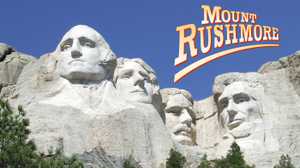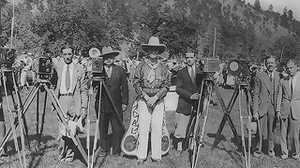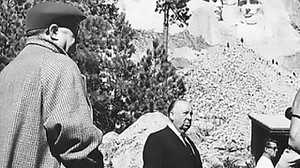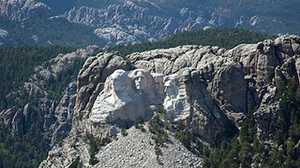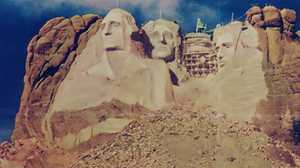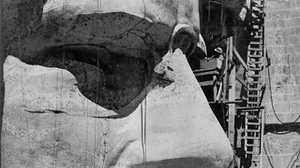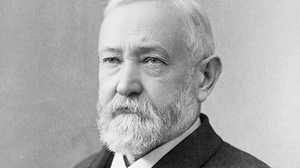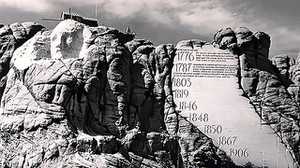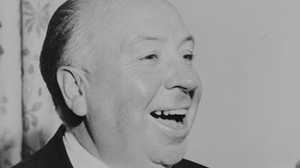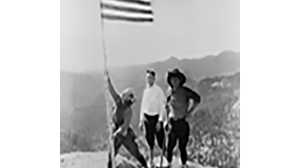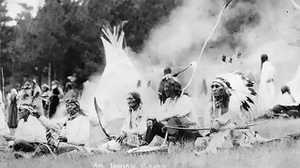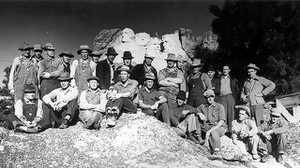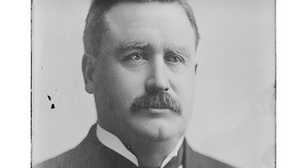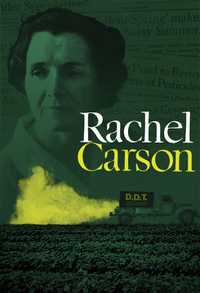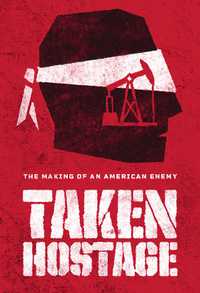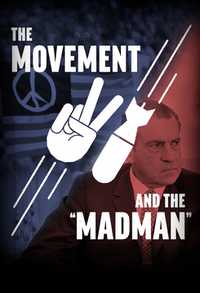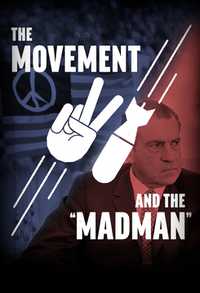Narrator: Deep in the Black Hills of South Dakota stands one of the biggest and unlikeliest monuments on the face of the earth -- a feat of modern engineering that relied on the ingenuity of the Ancient Greeks; a carving of surprising delicacy, fashioned with jack hammers . . . and dynamite; a work of public art that began without a whisper of public support.
Its size, its remote location, its compelling oddness begs the question: how'd it get there? The answer begins with one man . . . an excitable, erratic and gifted sculptor named Gutzon Borglum.
Rex Alan Smith, Author: When he was angry he was furious. When he was generous he was overwhelming. When he was being petty he was penurious. He was a hyperactive man who traveled in the middle of a self-generated whirlwind.
Mary Ellis Vhay, Gutzon Borglum's Daughter: He was so full of energy, I mean, it was a vital force within him, burning within him. He could charm anybody to do anything if he really put his mind to it. And he could also raise a terrible fuss if you didn't.
Gutzon Borglum: The dimensions of Washington's head would permit the Sphinx of Egypt to lie between the end of the nose and the eyebrow.
Narrator: Gutzon Borglum was an egomaniacal genius and a fetching blowhard, a bullish patriot and a wifty dreamer. When he began Mount Rushmore, he still believed that one man could change the world. A 16 year struggle with the mountain -- through withering criticism, lack of trained workers, constant delay and crushing debt -- would test that plain, rock-hard, American-made conviction.
On October 1st, 1925, a few hundred souls made their way up a rough mountain pass toward a seldom seen peak in the Black Hills of South Dakota. That day, at the base of Mount Rushmore, Gutzon Borglum announced his intent to create the Great American Memorial.
In the mountain granite, he would carve a monument befitting the world's newest power: statues of four American presidents, more than 30 stories tall. Gutzon Borlgum's monument would dwarf the Statue of Liberty, the Sphinx of Egypt, the Colossus of Rhodes.
Mary Ellis Vhay, Gutzon Borglum's Daughter: If you start way back when we first came here, my father was looked upon as a weirdo, and a crank. They thought he was really just very peculiar and he had big ideas that would go nowhere.
Rex Alan Smith, Author: This is a crazy idea in a society that is so recently removed from the frontier that everything had to be utilitarian. It had to have a purpose. And of what good were faces carved on a mountain even if you could do it, and who knew if you could do it?
Dr. Karl Wegner, Peter Norbeck's Grandson: First he told the Rapid City businessmen supposedly that he didn't need financial support from them. Then after that very first dedication ceremony in I believe in October of 1925, when he had dinner with them afterward, he said he really needed that $50,000 now. This is the sort of thing that angered the people of South Dakota who began to become very skeptical about him.
Narrator: In 1925, Gutzon Borglum wasn't much concerned with what the locals thought of him. His critics, he said, were mere "horseflies." If South Dakotans were too thick to seize the opportunity in this magnificent work of art, then they didn't deserve Gutzon Borglum. That's the way Borglum saw it, and that's all that mattered to him.
All his life, John Gutzon de la Mothe Borglum was hard-headed and self-absorbed. As a child, he decided he would make himself someone extraordinary; and he spent his life in that effort -- fueled by anger, energy and ego.
The son of Danish immigrants, Gutzon was born in Idaho in 1867 and raised in the West. His father had been a part of the Mormon migration west; his mother, he barely knew.
John Taliaferro, Author: Borglum was a child of polygamy. His father had two wives when he lived in Idaho -- Borglum's birth mother and his mother's sister. His father decided he didn't want to be a Mormon any more and decided to go back to Omaha where polygamy was taboo. It was decided that Gutzon's mother would be discarded from the family and never spoken of again.
Robin Borglum Carter, Granddaughter of Borglum: There were eight children in the family and there had been two wives at one time, and Gutzon's mother actually left the family and they were raised by the stepmother.
Mary Ellis Vhay, Gutzon Borglum's Daughter: He ran away from home because he was unhappy and at that, he started, I think when he was only five years old, and he finally built up the confidence within himself that he could do what he desired to do.
John Houser, Son of studio assistant: He had a deep sense of his own abilities, I think. He ran away from home a number of times to become an artist and wound up in California at a very early age studying art and he even said he was going to be famous before he was 30.
Narrator: In his twenties Gutzon moved from northern California to London to Paris, painting landscapes and portraits, trying on different styles, supporting himself and his first wife with marginal success. As he passed 30, Borglum was near broke, failing at marriage, and worse, unknown.
Robin Borglum Carter: He was very distraught when he was in Europe and he didn't feel like he was making money, he didn't feel like he had a name for himself. He wasn't happy, and he wanted to change all that. He wanted to be, be recognized.
Narrator: While in Paris, Borglum found his pole star, Auguste Rodin. Rodin's work was sculpture cast anew: modern, evocative and talked about. In the glow that surrounded the Great Artist, Borglum saw a reflection of his own future.
Robin Borglum Carter, Granddaughter of Borglum: In 1901 when he came back to the United States, he just burst into New York City sort of determined to become a very successful sculptor. And within those first ten years he designed over 100 pieces for St. John the Divine in New York City, he'd sold the marble Lincoln for the Rotunda, he'd sold the Mares of Diomedes to the Metropolitan. He'd done the Mackay statue in Reno, Nevada. He'd done Sheridan in Washington DC. I mean in the first ten years, he was doing all these things.
John Houser, Son of studio assistant: Every really great artist has something in their personality that they're able to impart into their work, that is unique and is only them. With Borglum I see the personality when I touch those surfaces a lot of time, I often expect almost to feel a little glaze of electricity that's traversing across the form. There's a life to it. There's a sense of movement. And, I think that they were done generally very quickly and very fast. My father said that oftentimes he would come in and do something just like this and then it'd be done. Sometimes he would even have his suit on and his Stetson, wearing his Stetson hat you know, and he would come in and model for 15 minutes and he would say, "Cast it," you know, and he'd walk out.
Narrator: Gutzon Borglum's most gripping creation . . . was Gutzon Borglum. From an obscure frontier boyhood, he'd made himself literate, continental, magnetic, a friend to the rich and famous — lord of a 500 acre estate in Connecticut. He was also rough around the edges, sharp in places and apt to injure. His politics could be crude: anti-Semitic, anti- immigrant and racist.
Borglum lived a series of poses, each meant to call attention. And he found that nothing drew attention like a public scrap. He skirmished with the rector of St. John the Divine, the mayor of New York, President Woodrow Wilson. "He was no mute, shrinking artist," said one friend. "He knew how to answer back. And the press loved him."
Gutzon's harshest attacks were aimed at other artists. He called one a "pinhead sculptor," and claimed that most of the nation's public monuments were worthless . . . and should be dynamited. This was America's colossal age, he said, and American artists should celebrate it.
John Houser, Son of studio assistant: An artist has a great many elements to work with, to create something aesthetic. You have the warmth and the coldness of color. You have the smoothness and the roughness of texture. You have the contrast from light and dark. You also have when you get to scale you find that scale is an aesthetic quality in itself. In other words, when you see something extremely large, it has an impact on you just because it's big.
Narrator: Borglum understood that most Americans could not be moved by beauty alone. "(Sheer mass) is emotional," he once wrote. "There is something in sheer volume that awes and terrifies, lifts us out of ourselves."
In 1915, the sculptor staked his reputation on the conviction that America demanded scale. That year, at a mountain in Georgia, he made bold to promise the Eighth Wonder of the World: a 400 foot high, one 1,500 foot wide monument to the confederacy.
John Houser, Son of studio assistant: When Borglum was called down to Stone Mountain originally, he was invited to do a small bust of Lee and put it on top of the mountain. And he told the Daughters of the Confederacy, he said, putting a bust of Lee on top of that mountain would be like pasting a postage stamp on a barn door, you know, it's incongruous. If you're going to talk about a mountain that size you have to talk about a piece of sculpture that's commensurate in one way or another. That sort of opened the door, I think, to him for mountain carving.
Mary Ellis Vhay, Gutzon Borglum's Daughter: Stone Mountain was the dream of Atlanta and the southerners who were down there, to have a commemorative memorial to Lee. But they didn't have any money. So, he mortgaged the place in Connecticut for a tremendous sum of money to get it started.
Narrator: By then, Borglum was a new father — and he liked to keep his family close. So with his second wife, Mary, and their two small children, Lincoln and Mary Ellis, Borglum set up a second household in Georgia. He gave up his smaller, more personal work — pipe dreams, he'd call them — and went to work at a scale no American artist had ever attempted.
The confederate monument turned out to be an exhilarating fight . . . and nearly disastrous. After a decade of planning, fundraising and work, Borglum had completed less than a tenth of the carving. The Stone Mountain Association fired Borglum, accusing him of "wasteful expenditures,' and an "ungovernable temper." In a fit of anger, Borglum destroyed his working models. The association, claiming ownership of those models, swore out a warrant for his arrest.
So at the beginning of 1925, Gutzon Borglum was a 57 year old fugitive . . . rheumatic, exhausted, publicly humiliated, and deeper in debt by the day.
Mary Ellis Vhay, Gutzon Borglum's Daughter: After Stone Mountain fell apart, it was very hard scrabble a lot of the time, but Mother was the one that kept payments up and did the things that had to be done and cut corners when it was possible.
Robin Borglum Carter, Granddaughter of Borglum: Mary's letters would be how are we going to a divide up this $100, who needs to be paid this week, who's not going to be paid, and when is the next amount of money coming in. So they were down to the very nitty gritty.
Narrator: Gutzon raced from Washington to North Carolina to Texas, trying to drum up new commissions, but the best offer fell from the sky. South Dakota's state historian, Doane Robinson, had seen newspaper accounts of people driving to Georgia just to see Gutzon's Stone Mountain carving. Robinson's far off, nearly forgotten state was in dire need of a roadside attraction; and he thought this mountain carving business might be just the ticket.
So Robinson wrote Borglum and asked him to consider a new project in the Black Hills, maybe statues of Lewis and Clark, Buffalo Bill, Chief Red Cloud — something to draw the tourists. Borglum took Robinson's suggestion and ran. Western figures are too parochial, he announced; he would carve national heroes. The first three were no brainers: George Washington, Thomas Jefferson, Abraham Lincoln. The fourth would be Borglum's great personal friend and political hero, Teddy Roosevelt.
And Borglum said he would carve his presidents on Mount Rushmore, a site he chose for its broad face, and a southeastern exposure that guaranteed the most dramatic light. To his 12-year-old son, Lincoln, he confided: "Nothing but the Almighty can stop me from completing this task."
John Taliaferro, Author: When he got the call to come to Mt. Rushmore this was a great chance to redeem himself, to do all the things he had ever wanted to do in a much larger scale than he'd even dared think about until that point. He could taste it from the second he got off the train in Rapid City.
Mary Ellis Vhay, Gutzon Borglum's Daughter: He had expected Stone Mountain to be the crowning achievement in his career, and here he was presented with a bigger crown. It was going to be bigger, larger. And all he needed to do was to get $1,000,000 or whatever, to do it.
Narrator: Doane Robinson was thrilled, and happy to let Borglum have his way with the planning. After all, he said, God only makes a Michelangelo or a Gutzon Borglum once every 1,000 years. The remainder of the state was less enthusiastic; that Mount Rushmore stood on ground sacred to the Lakota Sioux wasn't even the big problem. In the 1920s, South Dakotans simply didn't have a lot of spare cash for public monuments. A year after Borglum's plea for $50,000 seed money, locals had raised only $5,000.
And the proposed project hadn't exactly brought honor to the State; in fact, Mount Rushmore was a bit of a knee-slapper around the country. "Borglum is about to destroy another mountain," wrote one newspaper back East. "Thank God it is in South Dakota where no one will ever see it."
The sculptor had only one solid asset: South Dakota Senator Peter Norbeck. Peter Norbeck was the son of Norwegian immigrants, born in a sod dugout and raised poor on the South Dakota plains. He was stout, plain-spoken and quietly ambitious. As a young man, he'd made a fortune drilling wells, and then moved to politics.
Dr. Karl Wegner, Grandson of Sen. Peter Norbeck: Grandpa Norbeck has been described as rough as the Norwegian, northern pines, but also with the soul of an artist. His formal education was very limited, but somewhere in there he found the interest to pursue these more intellectual and artistic endeavors.
Mary Ellis Vhay, Gutzon Borglum's Daughter: He supported dad in everything. He got very cross with him at times when dad would demand more money and had to have more money, but also I think that Senator Norbeck was a bridge between dad and the local people.
Dr. Karl Wegner, Grandson of Sen. Peter Norbeck: He saw this as an opportunity to bring people to the Black Hills. Any tourists, any people we could bring into South Dakota from the outside brought their wallet, their dollars with them, and any outside dollars in this state that could be brought in were desperately needed.
Narrator: What Norbeck did first was convince President Calvin Coolidge to spend the summer in the Black Hills, maybe take in the mountain scenery, do a little fishing. Even before Coolidge got to town, Rapid City was fevered with Babbitt-like boosterism. And the Rapid City Commercial Club renewed their drive to raise cash for Senator Norbeck's carving.
By the time the President arrived, the Rushmore association had $42,000 in the bank -- and Borglum was in a lather too, planning a second (and more extravagant) dedication: one the President could attend, with the national press in tow. And on that August day, Silent Cal made a speech that surprised even Borglum.
Rex Alan Smith, Author: He started out by saying. "We have come here to dedicate a cornerstone laid by the hand of the Almighty." Further in the speech he said, "The people of South Dakota had been bearing this burden so far," — which they had not — and he felt the Government ought to help. And this was the beginning of getting Government support.
Narrator: With Coolidge's support, Norbeck pushed a bill through Congress authorizing federal matching funds for Mount Rushmore: one government dollar for every private dollar raised.
The problem was, in 1929, there had been only $50,000 raised. Still, with less than ten percent of his budget in hand, Gutzon Borglum rushed ahead, anxious to answer the big question: Could this colossal carving be done?
It was 500 feet to the top of Mount Rushmore. Nobody could be sure how much carveable granite existed beneath the richly creviced surface. Long, frozen winters would make work nearly impossible four months a year. Even more troubling to Borglum, was the pool of men available to do the work.
Getting able bodies wasn't the hard part. Jobs were scarce in the Black Hills in 1929, and Mount Rushmore offered some of the highest paying work around. But as dozens of men started to sign on, Borglum realized he was going to have to depend on locals -- the "untutored miners" he called them.
Rex Alan Smith, Author: A lot of these guys were tough, rough, brawling kind of guys. They used to say that the Keystone boys playpens were fenced with barbed wire. And that they only turned the other cheek when they were delivering a left hook.
Bob Hayes, Son of Worker: It didn't take too much training say to drill holes and so forth and run a jack hammer. It just took a lot of guts, you might say. Some people went up there and worked one day, and I've been told, and that was all they wanted. They couldn't stand the height and the dust and so forth.
Nick Clifford, Worker: It was pretty tough for your first time going over there and hanging in the bosun chair and try to punch holes in the granite. It took a lot of practice. And you didn't get much done your first day, I'll tell you that. Most of the jack hammers weighed about 40 or 50 pounds. And then you had to carry your steel with you also. So you had quite a load going down there.
Glenn Bradford, Worker: The wind was always a blowin' and it'd be pretty gusty. The wind always blew up there seems like. They was hangin' with a little three-eighths inch cable. And that cable looked pretty small to me, to hold them guys up there. And then they'd just shake pieces out of them when they'd turn them jack hammers on.
Narrator: Once the men had blasted off the surface rock, leaving a giant egg-shaped mass where Washington's face could be sculpted, Borglum spent days watching the light and shadow play on the expanse, then decided to rotate the face 20 degrees from his original plan. After that, the sculptor and assistants like Ivan Houser set to re creating the studio models on the side of the mountain.
The commonly used methods didn't apply; the mountain was simply too big. So Borglum turned the page back to a technique devised by the ancient Greeks.
John Houser, Son of studio assistant: In doing a big piece of sculpture one of the problems of course is the enlarging. You're trying to locate points in space, and at one scale and then you try to locate those same points in space at another scale. So what they did is, you have a beam coming straight out from a point that turns on a swivel, and you can note the degrees at which it is turned, and so as you turn the one on the little model and you can say it's off 30 degrees off to the right and it's out so many measurements and down so far and then in so far, and you can locate a specific point on Washington's cheek for instance. So then you can do the same thing up on the mountain.
Nick Clifford, Worker: This is what they called honeycombing. This was the next to the last step of finishing the faces. And they would drill these holes in. The pointers or Mr. Borglum would tell them how deep to drill the holes. You can see they were taking off more rock down here than they were up here. And it was probably right close to the face, maybe it was on like on a cheek or something like that. And they would take a sharp pointed piece of steel and they would hit in each one of these holes. Eventually this rock would pop off, and then they would use a bumping hammer — they called it bumping — and that would smooth the rock up just like it is today, that you see it on the mountain.
Narrator: Independence Day, 1930, just more than a year from the day real work began, Gutzon Borglum revealed to the world the first great granite visage. July 5th, Mount Rushmore was a dateline in papers across the country. Through that summer, newsreels of the dedication played at theaters nationwide. Suddenly, Rushmore was a fixed point in the American consciousness. And as work on Washington continued, tourists began making the trek to the see the strange sight in the Black Hills. In the first year alone, 27,000 people visited Mount Rushmore, now billed as "The Shrine of Democracy."
The early success confirmed Borglum's every plan. Now his men could race to the finish. The entire carving — four figures, each complete to the waist — would be done inside of four years, he figured . . . He'd figured wrong.
Within weeks of the Washington dedication, bad news began to pile up. Borglum had spent so much on the dedication ceremony that money ran out at the end of July, and work on the mountain slowed to a crawl. Rushmore's great champion, Senator Peter Norbeck, was diagnosed with cancer. The next year, things only got worse.
John Houser, Son of studio assistant: They were aware of course that there were going to be, faults and cracks in the rock, some of them were hard to detect. In fact they started Jefferson off to Washington's right, and they found out there wasn't enough stone there. The stone was too crumbly and it just wasn't of good quality.
Robin Borglum Carter, Granddaughter of Borglum: They had to blast that off after 18 months of work, which must have been heart breaking to do that, as tight as money was, and then to blast off what they'd spent all that time doing.
Narrator: By the end of 1931, the Rushmore Association was $16,000 in the red, with little hope of raising more private money.
Dr. Karl Wegner, Grandson of Sen. Peter Norbeck: They had this almost double whammy. The entire country, in fact much of the world was wrapped up in this horrendous financial depression. Then on top of that was the Dust Bowl days. There was no rain; the farmers could raise no crops. What little they could raise, it was almost impossible to market. They were leaving the state in droves. Those who stayed wondered why they were still here. And in 1932, the work at Rushmore had ground to a total halt. And again there was the specter of this whole thing just never being completed.
Interviewer (archival): When do you think this work will be completed Mr. Borglum?
Gutzon Borglum (archival): I'm trying to finish it so that the figures will be done by 1935 sufficiently . . .
Mary Ellis Vhay, Gutzon Borglum's Daughter: My father never wanted to admit any type of failure, and certainly he didn't want to admit it. I'm sure he did with mother, but he didn't with us. I mean it was always going to be, everything was going to be all right.
Robin Borglum Carter, Granddaughter of Borglum: He didn't show any despair, even to Mary very much. One letter that I found where he was in Washington for months trying to get money for Rushmore and it was a bad time and he wrote to her and said, "I'm just sick about what's happening, but this is the time to be courageous." And you know I think his spirit just kept him going and Mary kept him going.
Mary Ellis Vhay, Gutzon Borglum's Daughter: I don't think he would have been able to carry on if it hadn't been for my mother. She was always there, not driving him, but building up his ego, making him aware that he was a great sculptor.
Narrator: Even in the darkest days of Rushmore, Gutzon never lacked for ego. People who held sway, he liked to keep them informed. Congressmen, Senators, oil tycoons, William Randolph Hearst, the Duke of Windsor -- he wired them all, and often collect.
Mary Ellis Vhay, Gutzon Borglum's Daughter: He corresponded with anybody you could think of. And I mean from the heads of state on down to the practically the garbage men. Probably not the garbage men because he probably hadn't paid them.
Bob Hayes, Son of worker: He was coming across the state and he stopped at a little station and he wanted to fill up his car. And the young station attendant, you know, said, "Well you know I have to have money first." He said "Well don't you know who I am?" And the attendant said, "I know exactly who you are. That's why I have to have the money first."
Rex Alan Smith, Author: He felt that he should have free gasoline if he wanted it, he saw movies without paying, and his personality was so powerful they let him go ahead and do it. As he said many times, "I'm giving these people in the Black Hills an asset that'll bring in billions of dollars and they're persecuting me over a piddling parcel of groceries."
Narrator: Where money was concerned, Gutzon was fearless. He spent himself and his projects into the hole today, convinced he could win more tomorrow.
Dr. Karl Wegner: Borglum had this tendency to show up in Washington unannounced and appear before committees and attempt to schedule appointments with the president. He would give one set of financial projections to one committee or to one senator or to one congressman, and within a matter of hours or days come up with another set of figures, or he could say he could finish this project for $250,000, when everybody sitting in the room knew that there was no way in which that entire project could be completed for $250,000.
John Houser, Son of studio assistant: A number of times my father and Borglum were in the Senate seeking funding for Mount Rushmore. So one time they were up in the balcony at the Senate, and the Bill was on the floor and one of the Senators stood up and he was raging against Borglum, and he was calling, "Why are we trying to appropriate funds for this crazy genius?" And then that triggered Borglum. Borglum jumped to his feet, but before he could say anything my dad grabbed him by the coattails and pulled him down, and he said, "He called you a genius didn't he?"
Narrator: It was Senator Norbeck who saved Mount Rushmore -- with an assist from the deepening Depression. At the end of 1932, as the national economy slid downhill, President Herbert Hoover started passing out relief money. And Norbeck snared a 100,000 federal dollars for jobs on the mountain. Then he convinced the National Parks Service to take over the project, guaranteeing more funding.
In the spring of 1933, after nearly a year and a half of silence, work on the mountain began again. And the central crew was back: Hoot Leach, Howdy Peterson and his brother Merle, Jimmy Champion, Whiskey Art Johnson, Palooka Payne. They all knew they'd be shut down again for some reason, but they came back just the same.
Rex Alan Smith, Author: One of the great miracles of Rushmore is the miracle of the men, those dedicated guys, the Red Andersons, the Hoot Leaches, the Peterson boys and so on who came back and came back and came back and came back.
Nick Clifford, Worker: Had they not come back, there would be no Mount Rushmore as we know it today because Mr. Borglum, it was impossible for him to train a new crew every year. But these men were dedicated to the mountain. When the mountain would shut down for lack of money or in the wintertime, they'd all have to find another job. But when the spring would come around and they'd get the call to come back, they'd quit what they were doing and come back to work at the mountain.
Rex Alan Smith, Author: Red Anderson said, "At first it was just a job and just a crazy kind of a job at that." But as time went by, all of this started to change and they developed a sense, came together fused in a sense that they were creating a great thing.
Narrator: The men stuck it out in spite of their boss -- the Chief they called him, but only behind his back. Borglum rarely talked to his men, except to give orders. "He's a heckuva stone-carver," said one, "but he ain't no sweet-talker."
Gutzon Borglum: I'm not satisfied with how it turns under there and comes against the collar. You go on down there Payne. I want those points very carefully examined. I'll be down there in a few minutes.
Mary Ellis Vhay, Gutzon Borglum's Daughter: Dad might get furious at them if they were stupid, cause he could not stand stupidity. Anybody could make a mistake once, but not two or three times, and if they did two or three times he would usually have them fired. And that was another job that Lincoln had because if it was a good man Lincoln would have to talk him into coming back again. And then Dad would be sort of surprised to see him and he then he'd say "What have you been doing, Lincoln?"
Narrator: Lincoln Borglum, Gutzon's only son, was just 21 years old when the men went to work on the new Jefferson head. But despite Lincoln's youth, Gutzon left his son in charge of the mountain during his long and frequent absences.
Nick Clifford, Worker: He grew up with the mountain. Working so close with his father, it just had to be catchy. I mean he had a vision also of what the mountain was going to be like. You would never see him sittin' down. If you'd look up why Lincoln would be up on top looking down or lookin' at the faces, or where the men were carving. He was all over the mountain. You never saw him get mad or to chew anyone out. You could laugh with Lincoln and have a great time. When we went on our baseball trips Lincoln would always go, and if we did something good, why, he'd pat us on the back and tell us what a good job we'd done. And he was just a great guy.
Narrator: Lincoln had a calm, easy manner his father relied on -- more than anything, to mend relationships Gutzon broke. And throughout the mid-thirties, Gutzon was more combative than ever.
The Jefferson head continued to vex. The men blasted down 60 feet to find carve-able rock, but even then, huge fissures cut through the face. And there was a mass of feldspar that had to be dug out, leaving a gaping hole on the president's lip. Using Borglum's concoction of white lead, linseed oil and granite dust, the men filled in the cracks and divots as best they could. But it all took time and money. And with the National Parks Service now overseeing the project, it was up to a Rapid City farm implements dealer named John Boland to make sure money was spent according to federal guidelines — and not Gutzon's.
When Borglum needed money, he had to go to Boland and beg, and the sculptor grew to resent it. "I've got to go to Rapid City," he told Red Anderson one day, "and punch a certain son of a bitch right in the nose." Other days, Borglum threatened to walk away from Mount Rushmore entirely, leaving the unfinished monument like a scar on the Black Hills. With so much at stake, Senator Peter Norbeck's most critical job was handling the explosive and unpredictable artist.
Dr. Karl Wegner, Peter Norbeck's Grandson: Grandpa Norbeck was the one person whom Borglum respected enough to accept his judgment and conclusion about things. And in a number of his heated arguments and conflicts with Boland in particular, but by no means confined to John Boland, Grandpa Norbeck was able to step in and resolve or at least partially resolve some of the conflicts. And then something would erupt all over again.
Narrator: By the end of 1934, Peter Norbeck had had his fill. His four-year fight with cancer had drained his energy and his good humor. "I have lately come to feel that you will do something that will prevent the completion of Rushmore," he wrote to Borglum. "I have made over seven years of effort in this work. It has been a heavy drain on my strength and purse. It keeps getting worse."
But even as cancer ate away at him, and took his ability to speak, Peter Norbeck would not let the Rushmore project fall apart; in 1935, he strode into the Senate one last time and won a new $200,000 appropriation. But he knew it would be his last big fight.
As the Senator neared death, he was philosophical. "A week after I am gone, they will start to forget me. A decade and most people of South Dakota will be unable to even recall my name." It was Borglum's name, he thought, that would endure.
But in the summer of 1936 Peter Norbeck was front and center to see President Franklin Roosevelt dedicate the hard-won Jefferson sculpture.
FDR (archival): There were two people who told me about this in the early days. One of them was Mr. Borglum. And the other, Senator Norbeck.
Dr. Karl Wegner, Peter Norbeck's Grandson: It was one of the supreme days of my grandfather's life. I think for him, I, at least I have wondered if it didn't become a little like that of Borglum, that this was one of the crowning accomplishments of his life, to have made this possible. As my grandfather had said that Mount Rushmore is no longer a joke, it's no longer a dream. It's real. It's there.
Nick Clifford, Worker: Mr. Borglum always complained that the people bothered him when he was doing his work but he would always stop and someone wanted to ask a question or something like that. He'd like to stop and talk to the people too, so he could explain what he was accomplishing. He used to tell people, "The faces are in the mountain. All I have to do is bring them out."
Robin Borglum Carter, Granddaughter of Borglum: He never gave up seeing it as great art. And a lot of people would argue with that, that it was more of an engineering project than anything else, but he really saw it as art -- that he was going to bring the life of those four people to the forefront, just as you would if you were doing a small statue of them.
John Taliaferro, Author: As you get closer to Mt. Rushmore you can almost see the thumb print of a sculptor's hand in clay. Borglum would study it at different times of day, in different kinds of light, and, and make adjustments the way an artist would make adjustments with a little knife or with a little chisel in the studio: little fiddling things with the mountain that I'm sure cannot be seen from the observation deck today, but mattered only to Borglum.
Narrator: Even as he passed age 70, Gutzon Borglum was still trying to find ways to vivify his carving. In 1938 and 39, Abraham Lincoln and Teddy Roosevelt were rounding into recognizable form, but the sculptor was still worrying every site and shading. "Have to climb down over the face of Washington and back up the face of Jefferson," he wrote. "I ought to be getting tired of it all, but I am not . . . I now see that I will be able to make a real work of art of this big group. Back in my heart that has been a doubt for many years. I really have no help in that; in that I am absolutely alone."
It was an image he cultivated, this lonely fighter's posture, but there were people whose contributions even Gutzon could not deny. Borglum may have devised the plan to give a twinkle to the presidential eyes, but it was the workmen who sculpted the two-foot long shafts of granite in the middle of each pupil, so that sunlight bouncing off the exposed point gave life to the eyes.
Robin Borglum Carter, Granddaughter of Borglum: Gutzon seems to have complained a lot about the unskilled workers that he was faced with, but actually he was very proud of the men and very proud of the fact that he'd been able to train these people who were miners and who were just local, who had never worked on a mountain before, didn't know anything about art and he'd been able to take them and train them into doing what he wanted done.
Rex Alan Smith, Author: There were things about him that bothered them very much, but down underneath they developed a loyalty, it's amazing, they developed a basic loyalty to Gutzon Borglum. With all his flamboyance, unpredictability, irascibility, there was some kind of a flame in the man, a charisma, a something that inspired a deeper loyalty.
Narrator: By 1940, Gutzon Borglum had made himself someone extraordinary. He was the man who carved mountains. And he stood America's highest peak . . . he had achieved celebrity -- even pitching ads for Studebaker and Bromo-Seltzer.
Still, Gutzon saw so much to be done on his mountain. He meant to extend the sculptures down to the waist; was at work on a Hall of Records, a cavernous time capsule for storing the important documents of the American democracy. But more than anything, he was still trying to transform his mountain into a work of art, fighting the one thing he couldn't beat: time itself.
At the beginning of 1941, the coming World War overwhelmed Mount Rushmore. After a dozen years, Congress finally cut off funding for good. A week later, Gutzon Borglum was dead — suddenly and unexpectedly, at age 73 — from complications following surgery.
Dr. Karl Wegner, Peter Norbeck's Grandson: Lincoln Borglum, of course, had taken over after his father died. By then a major part of the work had been completed, but there was still a fair amount of trimming and cleaning up to do around the faces and, and the collars of and shoulders of some of the figures. And the great hall of records which had been another great ambition and dream of Borglum's pretty much perished in the process. The work at Rushmore just sort of gradually drew to a close.
Narrator: It took 14 years to carve Mount Rushmore. Men removed half a million tons of granite, driving 120 feet deep in places. George Washington's face is 60 feet long, his nose 20, and each eye is 11 feet wide. Roosevelt's moustache is 20 feet across. Lincoln's mole, 16 inches. The carving cost $989,992.32 — almost all of it from the United States treasury.
For the money, America got the biggest and oddest monument on the face of the earth — and one of the most compelling. Since 1930, more than 50,000,000 people have made pilgrimage to the remote cliff-side Shrine.
Robin Borglum Carter, Granddaughter of Borglum: I think in some ways Mount Rushmore was the worst legacy that Gutzon Borglum could leave because he always will be known as the sculptor who did Mount Rushmore and yet at the time that he started the mountain, when he was 60 years old, he was well known for being a sculptor of beautiful monuments and beautiful pieces, and he was probably on his way to having a reputation as a great American sculptor. I think that was really overshadowed by Rushmore.
Nick Clifford, Worker: I look up on the mountain and I think of Mr. Borglum, what a great man he was, what a wonderful sculptor he was. I think of Lincoln, who was a friend to all of the men. And then I think of all the men that I worked with and knew, and how dedicated these men were to the mountain, and they're all gone now. And I have to stop now.
Narrator: Like its sculptor, Mount Rushmore is loud, demanding of attention, and maddening. To naturalists, the carving is an eyesore; to native Americans, a desecration. It stands as a monument to energy and possibility, to national pride and an often unbecoming national self-satisfaction.
And like the biggest and boldest creations in America, Mount Rushmore was not built on good intentions alone. It also stands as a monument to the colossal, sometimes wounding, and surprisingly contagious ambition of a single man.
Gutzon Borglum (archival): I am allowing an extra three inches on all the features of the various Presidents in order to provide stone for the wear and tear of the elements, which cuts the granite down one inch every 100,000 years. Three inches would require 300,000 years to bring the work down to the point that I would like to finish it. In other words, the work will not be done for another 300,000 years, as it should be.
